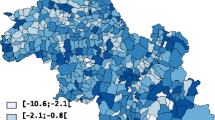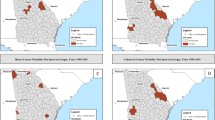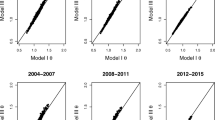Abstract
Objective: Region-specific maps of cancer incidence, mortality, late detection rates, and screening rates can be very helpful in the planning, targeting, and coordination of cancer control activities. Unfortunately, past efforts in this area have been few, and have not used appropriate statistical models that account for the correlation of rates across both neighboring regions and different cancer types. In this article we develop such models, and apply them to the problem of cancer control in the counties of Minnesota during the period 1993–1997. Methods: We use hierarchical Bayesian spatial statistical methods, implemented using modern Markov chain Monte Carlo computing techniques and software. Results: Our approach results in spatially smoothed maps emphasizing either cancer prevention or cancer outcome for breast, colorectal, and lung cancer, as well as an overall map which combines results from these three individual cancers. Conclusions: Our methods enable us to produce a more statistically accurate picture of the geographic distribution of important cancer prevention and outcome variables in Minnesota, and appear useful for making decisions regarding targeting cancer control resources within the state.
Similar content being viewed by others
References
Wennberg JE, ed. (1999) Dartmouth Atlas of Healthcare in the United States 1999. Chicago, IL: American Hospital Association. Web address: http://www.dartmouthatlas.org; accessed January 2002.
Abed J, Reilley B, Butler MO, Kean T, Wong F, Hohman K (2000) Comprehensive Cancer Control Initiative of the Centers for Disease Control and Prevention: an example of participatory innovation diffusion. J Public Health Manage Pract 6: 79–92.
Suarez L, Margin J, Weiss N (1991) Data-based intervention for cancer control in Texas. Texas Med 87: 70–77.
Pommerenke FA, Miller RW, Srivastava S, Ackermann SP (1994) Targeting cancer control: the state cancer control map and data program. Am J Public Health 84: 1479–1482.
National Program of Cancer Registries (2001) State/Territory Profile for Kentucky. Available at http://www.cdc.gov/cancer/npcr/ profiles/ky-npcr01.pdf. Accessed 01/29/2002.
Penberthy L, Stivers C (2000) Analysis of cancer risk in district health departments in Virginia, 1992–1995. Technical report, Cancer Prevention and Control Project, Virginia Department of Health.
National Cancer Institute (2002) PDQ Summary on Prostate Cancer Screening. Available at http://www.cancer.gov/cancer_information/. Accessed 01/23/2002.
Cancer Surveillance and Control Program (1997) Case completeness and data quality audit: Minnesota Cancer Surveillance System 1994–1995. Technical report, Minnesota Cancer Surveillance System, Minnesota Department of Health.
Surveillance, Epidemiology and End Results Program (1986) Summary Staging Guide. Baltimore, MD: National Cancer Institute, NIH Publication No. 86–2313.
Lengerich EJ, ed. (1999) Indicators for Chronic Disease Surveillance: Consensus of CSTE, ASTCDPD, and CDC. Atlanta, GA: Council of State and Territorial Epidemiologists.
Carlin BP, Louis TA (2000) Bayes and Empirical Bayes Methods for Data Analysis, 2nd ed. Boca Raton, FL: Chapman & Hall/ CRC Press.
Besag J, York JC, Mollie´ A (1991) Bayesian image restoration, with two applications in spatial statistics (with discussion). Ann Inst Stat Math 43: 1–59.
Wikle CK, Milliff RF, Nychka D, Berliner LM (2001) Spatiotemporal hierarchical Bayesian modeling: tropical ocean surface winds. J Am Statist Assoc 96: 382–397.
Metropolis N, Rosenbluth AW, Rosenbluth MN, Teller AH, Teller E (1953) Equations of state calculations by fast computing machines. J Chem Phys 21: 1087–1091.
Hastings WK (1970) Monte Carlo sampling methods using Markov chains and their applications. Biometrika 57: 97–109.
Geman S, Geman D (1984) Stochastic relaxation, Gibbs distributions and the Bayesian restoration of images. IEEE Trans Pattern Anal Machine Intell 6: 721–741.
Gelfand AE, Smith AFM (1990) Sampling-based approaches to calculating marginal densities. J Am Stat Assoc 85: 398–409.
Gelman A, Rubin DB (1992) Inference from iterative simulation using multiple sequences (with discussion). Stat Sci 7: 457–511.
Wang F, Wall MM (2001) Modeling multivariate data with a common spatial factor. Research Report 2001–008, Division of Biostatistics, University of Minnesota.
Xia H, Carlin BP (1998) Spatio-temporal models with errors in covariates: mapping Ohio lung cancer mortality. Stat Med 17: 2025–2043.
Waller L, Turnbull B, Clark L, Nasca P (1992) Chronic disease surveillance and testing of clustering of disease and exposure: application to leukemia incidence and TCE-contaminated dump sites in upstate New York. Environmetrics 3: 281–300.
Louis TA (1984) Estimating a population of parameter values using Bayes and empirical Bayes methods. J Am Stat Assoc 79: 393–398.
Ghosh M (1992) Constrained Bayes estimates with applications. J Am Stat Assoc 87: 533–540. Minnesota cancer control maps 915
Shen W, Louis TA (1998) Triple-goal estimates in two-stage hierarchical models. J R Stat Soc B 60: 455–471.
Conlon EM, Louis TA (1999) Addressing multiple goals in evaluating region-specific risk using Bayesian methods. In Lawson A, Biggeri A, Boöhning D, et al., eds. Disease Mapping and Risk Assessment for Public Health. New York: Wiley, pp. 31–47.
Shen W, Louis TA (2000) Triple-goal estimates for disease mapping. Stat Med 19: 2295–2308.
Mardia KV (1988) Multi-dimensional multivariate Gaussian Markov random fields with application to image processing. J Multivar Anal 24: 265–284.
Gelfand AE, Vounatsou P (2002) Proper multivariate conditional autoregressive models for spatial data analysis. Biostatistics (In press).
Carlin BP, Banerjee S (2002) Parametric and semiparametric frailty models for spatio-temporally correlated multivariate survival data (with discussion). In: Bernardo JM, Berger JO, Dawid AP, Smith AFM, eds. Bayesian Statistics 7. Oxford: Oxford University Press (In press).
Goodman DG, Wennberg JE (1999) Maps and health: the challenges of interpretation (editorial). J Public Health Manage Pract 5: xiii-xvii.
Author information
Authors and Affiliations
Rights and permissions
About this article
Cite this article
Short, M., Carlin, B.P. & Bushhouse, S. Using hierarchical spatial models for cancer control planning in Minnesota (United States). Cancer Causes Control 13, 903–916 (2002). https://doi.org/10.1023/A:1021980820140
Issue Date:
DOI: https://doi.org/10.1023/A:1021980820140




